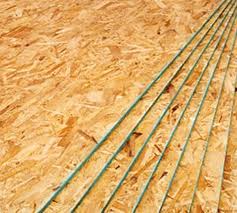 Oriented Strand Board (OSB) is a manufactured wood product that is often substituted for plywood and used to structurally sheath walls, roofs and floors of residential, commercial and industrial buildings. Unlike plywood, which is manufactured by bonding thin veneers of wood products together, OSB is made with 3” to 4” long strands of wood, oriented with their grains parallel, then compressed and bonded together using wax and resin adhesives to form plywood size sheets.
Oriented Strand Board (OSB) is a manufactured wood product that is often substituted for plywood and used to structurally sheath walls, roofs and floors of residential, commercial and industrial buildings. Unlike plywood, which is manufactured by bonding thin veneers of wood products together, OSB is made with 3” to 4” long strands of wood, oriented with their grains parallel, then compressed and bonded together using wax and resin adhesives to form plywood size sheets.
Susceptible to Moisture. Unlike most plywoods, which can withstand several cycles of wetting and drying when exposed to moisture, the deterioration of OSB starts with the first exposure to moisture. When subjected to rain or other moisture in an unprotected condition, OSB can swell up to 25% of its original thickness resulting in loss of density and strength. Unlike plywood, OSB does not regain its original structural properties when dried. When OSB swells, the nails attaching it to studs and joists break through the outer layers of the OSB and engage a material with less density. This reduces the strength needed to resist wind and earthquake forces and can imperil life-safety.
Mold. In addition to the loss of structural capacity, increased moisture content of OSB can lead to the formation of mold and fungus growth within the material itself. Many of the OSB products contain hardwoods such as Aspen which provide food for mold and fungus.
Maintenance. Associations with OSB as roof, floor or wall sheathing (typically a 2 to 5-story buildings less that 20 years old) care should be taken to protect and maintain the membranes that keep water away from the OSB. Maintenance examples include:
- Roofs. Finish roofing materials such as Spanish or flat tiles are required to be installed over one or more layers of roofing felt (tar paper) Roofing leaks may occur when the roofing felts are damaged or penetrated or a failure occurs in the roof flashing. Any leak allowing moisture to reach the OSB will result in permanent swelling of the OSB and potential mold and fungus growth. Associations should have their roofs, flashing and gutters/downspouts annually inspected and maintained.
-
Exterior Walls. The most prevalent wall construction in Southern California for wood framed condominiums consists of 7/8” thick stucco applied over one or more layers of building paper over plywood or OSB sheathing. Every time a nail or screw is placed into the stucco finish, the probability exists that the building paper membrane has been violated and an entry for water created. Swelling of the OSB can permanently damage stucco finishes and promote mold and fungus growth in the walls
-
Floors. Floor assemblies with OSB are prone to water damage, particularly in kitchen and bath areas. The greatest risks occur in areas of permeable floor covering such as carpet or T&G wood floor systems. The problem gets worse in bathroom areas where leakage can occur around poorly sealed toilets and bath tubs.
Information submitted by Garry D. Myers, P.E. S.E., Partner with MHP Structural Engineers.
ASSISTANCE: Associations needing legal assistance can contact us. To stay current with issues affecting community associations, subscribe to the Davis-Stirling Newsletter.